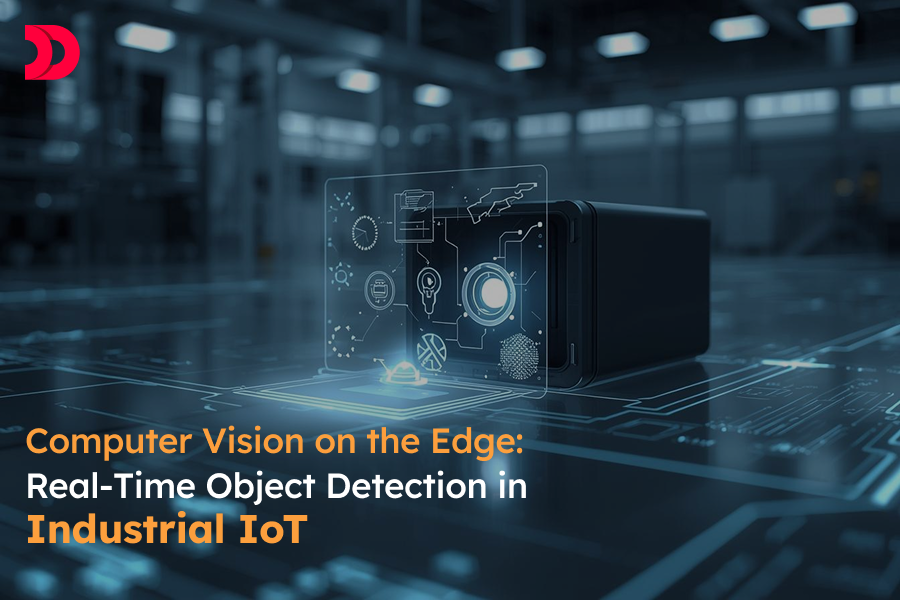Transforming Business Data with Snowflake: A Practical Guide
Imagine running a large retail group with thousands of stores. Each day, you would obtain humongous amounts of data on how many goods you sold, how much you have in... Continue Reading

The prevalence of Industrial IoT (IIoT) has brought in a massive volume of visual data as companies put cameras everywhere. Whether it is monitoring assembly lines or watching for safety violations, cameras or CCTVs always remain helpful. However, this vast data is meaningless if companies fail to process it into actionable insights. When a machine is about to fail or a worker is in a danger zone, there is no scope for delay of even a few seconds.
This critical situation shows the limitations of centralized cloud computing. It is time-consuming to send a video to a distant server and wait for the AI model to give the result for sending the action command back. This leads to unacceptable latency, and edge computing brings its solution. It moves the heavy computational work right next to the data source. Real-time applications get immediate feedback using the Edge-powered computer vision.
This blog talks about the role of computer vision on the Edge in real-time object detection. Let’s start with an understanding of the concept- edge-based computer vision.
Edge-based computer vision is the process of capturing, analyzing, and acting upon visual data directly on the device or a local gateway. Unlike cloud computing, this concept involves keeping the edge device (a small server or an embedded system) close to the camera. This device runs the AI model as an interface and triggers a predefined action, like stopping the machine in real time. Minimal latency is the biggest advantage of edge-based computer vision.
Edge setups can significantly reduce bandwidth costs because they do not need to stream high-resolution video over the Internet. They offer more reliability and ensure data privacy by processing visual data at a local level. However, it has a set of constraints for enterprises. Let’s dig deep into the top hurdles in real-time object detection in edge computing.
The main hurdle of edge computing is achieving optimal processing speed with the near-zero latency of the AI model. Bandwidth limits loom large, especially when it comes to transmitting initial model updates. Unreliable or intermittent connectivity in remote sites or factory floors can create an issue. Furthermore, it is essential to have robust local storage and synchronization protocols to get the benefit of edge computing.
Finally, handling sensitive visual data at the endpoint requires stringent protocols for data privacy and security to prevent unauthorized access. A reputable Edge computing services provider can help enterprises overcome these challenges effectively.
These days, different, lightweight models for edge-based computer vision are available. These models are optimized for resource-constrained devices, and they are in stark contrast with the high-fidelity models run in the cloud. Here are the three top lightweight models for efficient inference in devices-
Specialized hardware is essential to accelerate the inference step of these lightweight models. The NVIDIA Jetson series is such hardware that provides powerful embedded GPUs. It offers high parallel processing for real-time enterprise-grade applications. Other examples of hardware include Google Coral TPU (Tensor Processing Unit) and Raspberry Pi. Let’s have a glimpse of some IIoT use cases with edge-based computer vision for different sectors.
Edge-powered computer vision is beneficial for making immediate and actionable decisions in modern industries. For example, the QC department needs a system to identify critical anomalies and trigger an immediate automated response to stop the assembly line. Another example is edge AI that constantly checks for OSHA compliance to ensure the worker’s safety. Another use is for predictive maintenance to detect the early indicators of equipment failures.
Companies across different industry sectors utilize real-world applications of Edge AI. The logistics industry, shipping hubs use cameras on dock doors to monitor inventory in real time. It is beneficial for detecting damaged goods and reducing mispicks during sorting. The manufacturing sector uses dedicated edge devices to inspect microelectronics components for minute issues with sub-second latency.
Local inspection using edge devices enables companies to ensure near-perfect quality control in throughput while minimizing human errors. It contributes to increasing the overall efficiency and reliability of high-volume production.
Edge technology is highly beneficial for modern enterprises. However, it is essential to employ several optimization techniques to leverage its advantage and address hardware-related limitations. The primary optimization method is model compression or pruning. This method involves the removal of redundant weights and connections within the neural network to reduce the computational requirements of the model.
Quantization is another major technique that reduces the numerical precision of the model’s weights. For instance, this technique changes the model’s bulky 32-bit floating-point numbers to compact 8-bit integers. This reduction in data size can accelerate computation capabilities and maintain performance.
Hardware acceleration is also a useful optimization method. It leverages dedicated chips like TPUs or embedded GPUs to execute the edge model’s intensive matrix multiplication operations at high speed. This speed is higher than that of a general-purpose CPU. Companies can implement the most suitable optimizable techniques with the help of a reliable edge solutions provider.
Conventional cloud computing cannot meet the low-latency requirements of modern industrial Computer Vision. Edge computing can address this challenge with lightweight, highly optimized models like YOLO and MobileNet deployed on purpose-built hardware like the NVIDIA Jetson. A proper optimization technique can make Edge-based computer vision more effective, prioritizing local processing.
Edge-powered computer vision is beneficial for core industry sectors, including manufacturing and logistics. However, it is essential to choose the right lightweight model, the most suitable purpose-built hardware and ensure their seamless combination. An experienced Edge solution provider can help companies gain the advantage of this revolutionary technology and the next phase of IIoT.
Frequently Asked Questions
Edge computing is useful for computer vision to achieve ultra-low latency for real-time decision-making. Industries can reduce bandwidth costs significantly by processing data locally and maintaining reliability.
Lightweight and optimized models like YOLO (You Only Look Once) and MobileNet are preferred options because they offer a high balance of speed and acceptable accuracy.
Deployment of computer vision on edge devices involves model optimization using techniques like quantization and compression, selecting appropriate specialized edge hardware, and using containers.
Imagine running a large retail group with thousands of stores. Each day, you would obtain humongous amounts of data on how many goods you sold, how much you have in... Continue Reading
Feel free to call or visit us anytime; we strive to respond to all inquiries within 24 hours.
